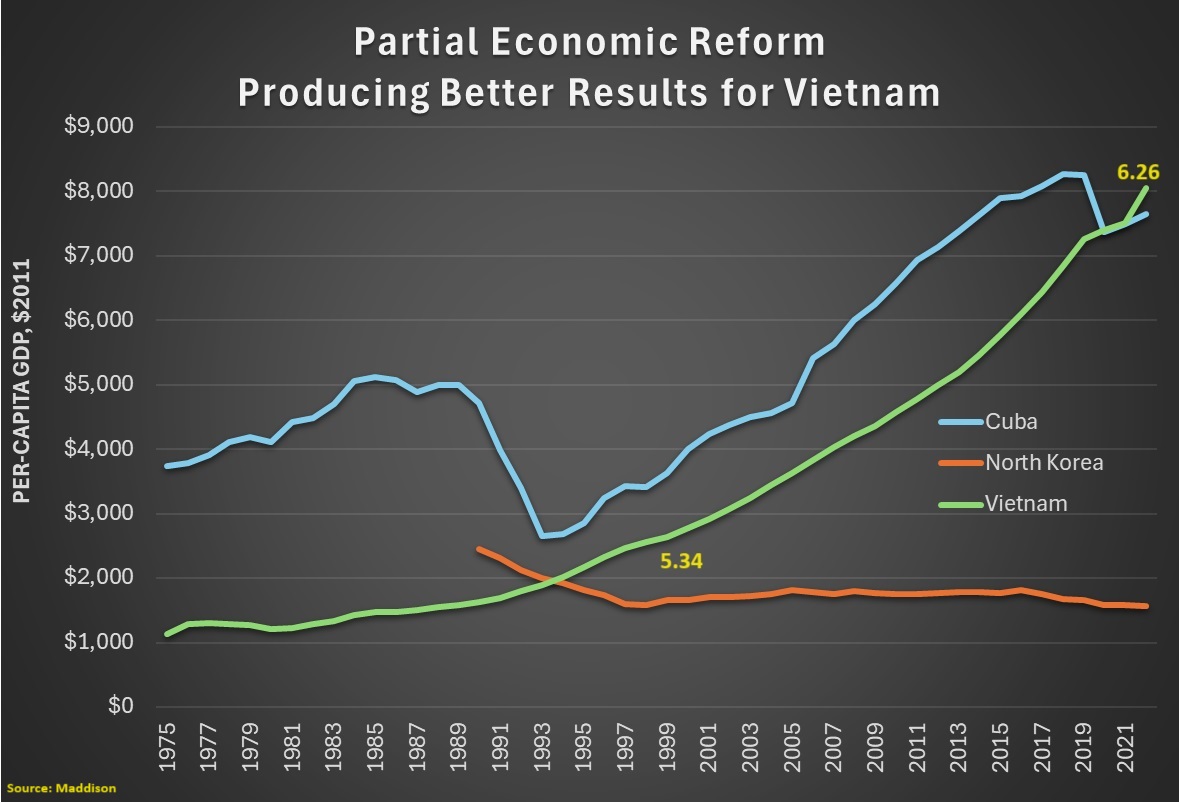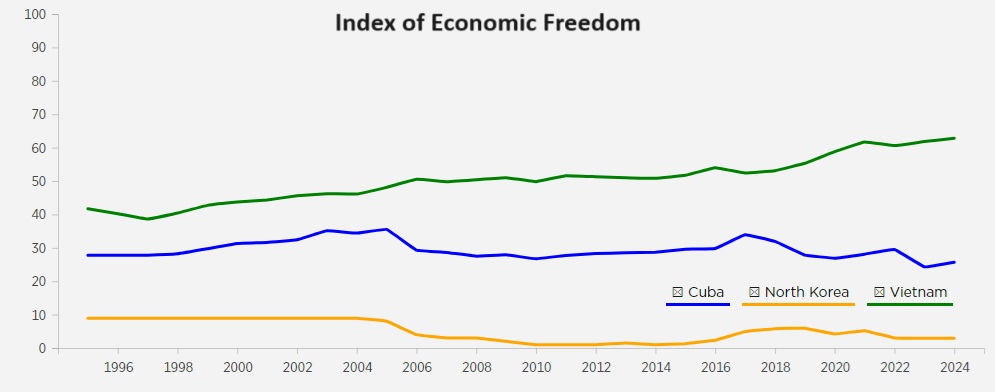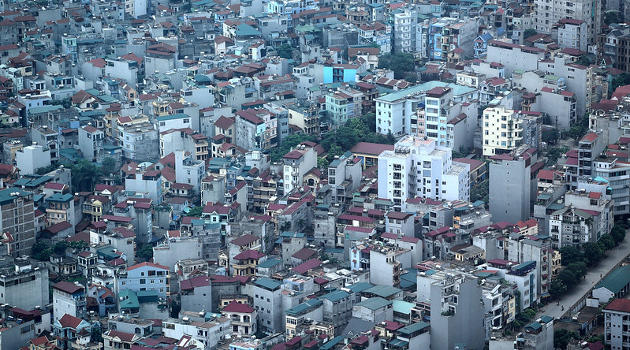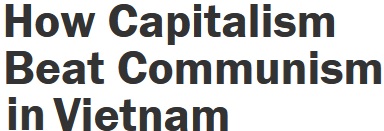Communism is a terrible and evil system with a deadly track record.
The bad news is that communism still exists, with the basket case of North Korea being an example of a country that has retained traditional Marxist socialism.
The good news is that many nations escaped communism when the Soviet Union collapsed (thank you, President Reagan).
To varying degrees, these countries have shifted away from socialism and adopted free markets. The Baltic nations are probably the best example.
There’s also good news in that some nations are still officially communist, but have taken some steps to liberalize their economies.
I’ve written many times, for instance, about China’s partial economic reform (followed by a bit of backsliding).
Today’s column will be about Vietnam, another nation that is officially communist but has nonetheless reduced government control over the economy.
Let’s start with this chart, based on Maddison data, comparing per-capita GDP in Vietnam, Cuba, and North Korea.

Vietnam was very poor in the 1970s and 1980s, trailing way behind even backward Cuba.
But when the Soviet Union joined the “ash heap of history” and no longer could subsidize Cuba, that caused per-capita GDP to plunge almost to the level of Vietnam and North Korea (data only available staring in 1990).
Notice, however, what happened to North Vietnam starting in the late 1980s. It’s per-capita GDP began to climb. Why? Presumably in part because its economic freedom score improved.
There’s no EFW data for the 1900s, but it’s worth noting that Vietnam’s score improved from 5.34 in 2000 (on a 0-10 scale) to 6.26 in the most recent edition of Economic Freedom of the World.
No wonder Vietnam has now passed Cuba when looking at per-capita GDP.
Rainer Zitelmann wrote a book entitled, How Nations Escape Poverty: Vietnam, Poland, and the Origins of Prosperity. He summarized some of his analysis about Vietnam in a column for Reason.
He starts with a discussion of the horrible policy that the country used to have.
People often had to wait hours, sometimes all day, to get a little food, and those who wanted a better chance of leaving with food came at night. They were already queuing up before the food was even delivered, in the hope that it would arrive at some point. …The amount of food you got depended on your family’s status. State employees received more, factory workers less. …Today the Vietnamese call this era Thoi Bao Cap—”the subsidy period.” It was the time of a socialist planned economy, before the free market reforms of the late 1980s. …Vietnam relied on food aid from the United Nations and financial assistance from the Soviet Union and other Eastern Bloc countries. As late as 1993, 79.7 percent of the Vietnamese population was living in poverty.
He then summarizes some of the good things that have happened in more-recent decades.
Vietnam is now one of the most dynamic countries in the world, with a vibrant economy that creates great opportunities for hardworking people and entrepreneurs. Once a country unable to produce enough rice to feed its own population, it has become one of the world’s largest rice exporters, and a major electronics exporter too. …There was no great tidal wave of privatizations, as in some Eastern European countries. Instead, state-owned enterprises simply declined in significance in relation to the private economy. Their subsidies were reduced, forcing them to work more efficiently and compete in the marketplace. Many unviable enterprises had to file for bankruptcy, and the overall number of employees in state-owned enterprises fell by about 30 percent (more than 800,000 workers) from 1989 to 1992. …Vietnam’s gross domestic product grew by 7.9 percent a year from 1990 to 1996, faster than any other Asian country but China. Poverty fell sharply. By the World Bank’s standard for extreme poverty—living on less than $1.90 a day—52.3 percent of the Vietnamese population was living in extreme poverty in 1993. By 2008, the figure had fallen to 14.1 percent. By 2020, it was only 1 percent.
Jon Miltimore also wrote about Vietnam in a column for the American Institute for Economic Research.
Here are some excerpts, starting with the bad news.
Though President Ho Chi Minh had promised in 1969 that defeating the Americans would allow socialists “to rebuild our land ten times more beautiful,” the postwar period was marked by economic decline. Vietnam was primarily an agricultural economy, and collectivization of farming had achieved results that were little different from previous collectivization attempts by the likes of Stalin and Mao. …by 1980, Vietnam, once an exporter of rice, was producing just 14 million tons of rice annually, even though it required 16 million tons to feed its own population. …Planners also instituted aggressive policies to nationalize industries in Vietnam. …Price controls — particularly rent control policies, which are notoriously destructive — also played a key role in Vietnam’s economic decline. …Throughout the 1980s and even into the 1990s, hunger was omnipresent for many Vietnamese people. As late as 1993, 80 percent of Vietnam’s population lived in poverty.
Now for the good news.
…in one of the most remarkable stories in modern history, poverty in Vietnam stands at roughly 4 percent, according to the Asian Development Bank. …aid to Vietnam was drying up in the 1980s and early 1990s. Because the Soviet Union was suffering its own economic collapse, billions of dollars in aid that would have gone to Vietnam were not sent. …the Vietnamese began spontaneously to create their own market economy to survive. State officials increasingly turned a blind eye to price control-violations… In response to this burgeoning economy, socialist leaders did something else quite extraordinary: they embraced the market economy and admitted their own “mistakes.” …In 1987, a new investment law was passed that showed Vietnam was open for business. The law promised that the state would not expropriate or nationalize foreign property or capital. …Today, Vietnam is one of America’s top-ten trading partners. The nation’s primary exports, which were once coffee and coconuts, are computers, mobile phones, and other electronics. It was one of the most miraculous economic transformations in history, and it achieved amazing results. From 1990 to 2022, per capita GDP in Vietnam increased more than fivefold.
I’ll close by looking at some data from the latest edition of the Index of Economic Freedom, which does include estimates for economic liberty for pre-2000 Vietnam, as well as for Cuba and North Korea.
You’ll notice that economic liberty in Cuba and North Korea declined between 1995-2024. But in Vietnam, economic freedom jumped from 41.7 to 62.8.

No wonder Vietnam is out-performing the other two communist nations.
To be sure, Vietnam’s economic policy is still bad. But bad is better than terrible. And terrible is better than utterly atrocious.
Vietnam has take the first steps in what hopefully will be a long journey.
Giving the private sector some breathing room is a good idea. Giving the private sector a lot of breathing room is even better…at least if the goal is to avoid the middle-income trap and become a rich nation.
———
Image credit: World Bank Photo Collection | CC BY-NC-ND 2.0.



